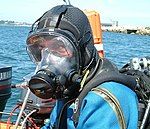Tunnel vision
Tunnel vision (also known as Kalnienk vision) is the loss of peripheral vision with retention of central vision, resulting in a constricted circular tunnel-like field of vision.[1]
Medical / biological causes
Tunnel vision can be caused by:
- Glaucoma, a disease of the eye.
- Retinitis pigmentosa, a disease of the eye.
- Blood loss (hypovolemia)
- Alcohol consumption causes tunnel vision.[2] In addition, the vision becomes blurred or double since eye muscles lose their precision causing them to be unable to focus on the same object.
- Sustained (1 second or more) high accelerations.[3] Typically, flying an airplane with a centripetal acceleration of up to or over 39 m/s2 (4gs) with the head towards the center of curvature, common in aerobatic or fighter pilots. In these cases, tunnel vision andgreyout may proceed to a g-force induced Loss Of Consciousness (g-LOC).
- Hallucinogenic drugs, in particular the dissociatives.
- Extreme fear or distress, most often in the context of a panic attack.
- Excitement or extreme pleasure such as on a roller-coaster, causing a surge of adrenaline in the body.
- During periods of high adrenaline production, such as an intense physical fight.
- Altitude sickness, hypoxia in passenger aircraft[4]
- Exposure to oxygen at a partial pressure above 1.5-2 atmospheres, producing central nervous system oxygen toxicity, called narcosis.[5] Other symptoms can include dizziness, nausea, blindness, fatigue, anxiety, confusion and lack of coordination.
- Pituitary tumours (or other brain tumours that compress the optic chiasm)
- Prolonged exposure to air contaminated with heated hydraulic fluids and oils, as can sometimes happen in passenger aircraft.[6]
- Severe cataracts, causing a removal of most of the field of vision
- During the aura phase of a migraine
- Intense anger, due to the body being rapidly flooded with adrenaline and oxygen
- A bite from a Black Mamba and other snakes with the same strength venom.
- Mercury poisoning (especially Methylmercury)
When combined with piloting an aircraft, driving, crossing roads or operating heavy machinery, the consequences can be fatal.
Eyeglass users
Eyeglass users experience tunnel vision to varying degrees due to the corrective lens only providing a small area of proper focus, with the rest of the field of view beyond the lenses being unfocused and blurry.
Where a naturally sighted person only needs to move their eyes to see an object far to the side or far down, the eyeglass wearer may need to move their whole head to point the eyeglasses towards the target object.
The eyeglass frame also blocks the view of the world with a thin opaque boundary separating the lens area from the rest of the field of view. The eyeglass frame is capable of obscuring small objects and details in the peripheral field.
Mask, goggle, and helmet users
Activities which require a protective mask, safety goggles, or fully enclosing protective helmet can also result in an experience approximating tunnel vision.
Underwater diving masks using a single flat transparent lens usually have the lens surface several centimeters from the eyes. The lens is typically enclosed with an opaque black rubber sealing shell to keep out water. For this type of mask the peripheral field of the diver is extremely limited. Generally, the peripheral field of a diving mask is improved if the lenses are as close to the eye as possible, or if the lenses are large, multi-window, or is a curved wrap-around design.
Protective helmets such as a welding helmet restrict vision to an extremely small slot or hole, with no peripheral perception at all. This is done out of necessity so that ultraviolet radiation emitted from the welding arc does not damage the welder's eyes due to reflections off of shiny objects in the peripheral field.
Optical instruments
Binoculars, telescopes, and microscopes induce an experience of extreme tunnel vision due to the design of the optical components.
A wide field microscope or telescope generally requires much larger diameter and thicker lenses, or complex parabolic mirror assemblies, either of which results in significantly greater cost for construction of the optical device.
Wide-field binoculars are possible, but require bulkier, heavier, and more complex eyepieces. The diameter of the objective lenses is unimportant for field of view.[7] The widest-angle eyepieces used in telescopes are so large that two would not fit side-by-side for use in binoculars.





.jpg)

.jpg)
.jpg)



No comments:
Post a Comment